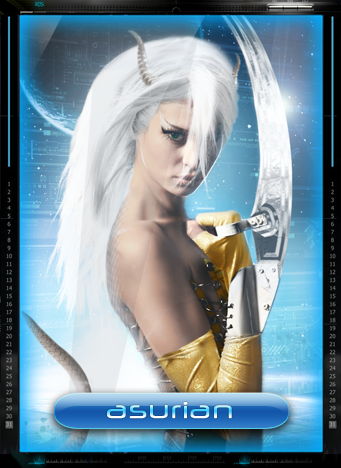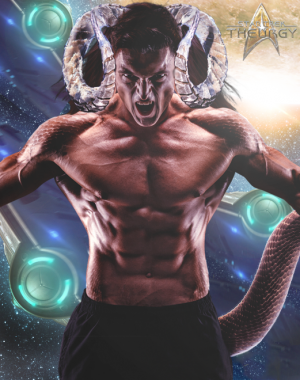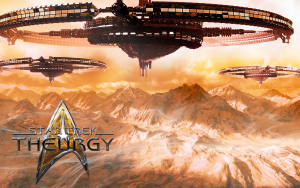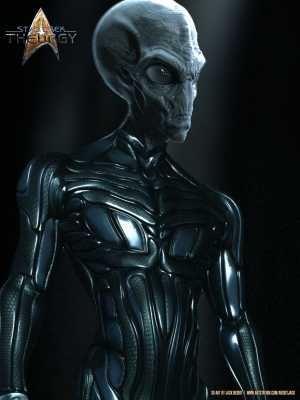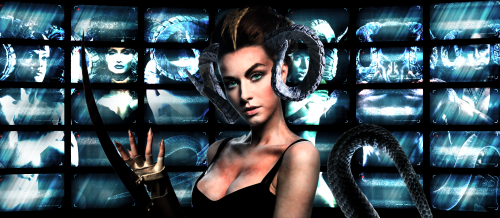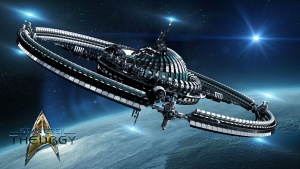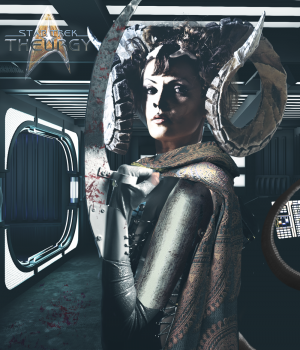Asurian
From Star Trek: Theurgy Wiki
Asurians were a young, small race of people that should never have survived, but against all odds, they did. They lived on a set of spaceships as opposed to a planet and searched for a home to call their own. They were fair of skin and white of hair, had horns and tails, and an extra organ that not only gave them a long life-span, but regenerative abilities.
Physiology
Due to their unusual evolutionary path, Asurian diploid cells contained 57 chromosomes. Haploid cells contained 28 whole chromosomes, and one half-chromosome. Sheromi believed interspecies breeding was a flaw introduced by the Preservers by accident, and wished to keep their races from irresponsible breeding. As such, all races the Sheromi have touched typically included a half-chromosome in their diploid cells. It was nearly impossible for Asurians to have biological children with other races, even with genetic assistance because of this.
Asurians had a long life span usually ranging from three hundred to four hundred years. Their skin was naturally pale and all had white hair. Their normal eye color varied, but was usually close to their blood color due to lack of pigmentation. It was common for some Asurians to have dark eye colors, such as greens, blues, and browns, due to mutations introduced by an old Sheromi genetic enhancement. Their ears were slightly pointed, but did not give them a stronger sense of hearing.
They had a tail stemming from the pelvic area that could be anywhere from three to five feet long. The top part of the tail was typically covered in light scales, and the bottom part was exposed, highly sensitive flesh. A common adage in Asurian culture stated that one could go blind from playing with their tail too much. This was untrue.
Asurian scales were typically light in color. They covered the more sensitive parts of the Asurian body, such as genitals, inner thighs, parts of the torso, between the shoulder blades (covering the Velsren sac), and down the spine. These were simply the most common places to find scales. Each Asurian had a unique pattern of scales across their body, some even found scales on their face or across their hands and feet. These scales could be removed, but it was painful to remove a healthy scale. (Dead or damaged scales didn't hurt and usually fell out on their own, much like dead hair.) There were treatments available to stop the growth of scales in unwanted places, but the Velsren sac would occasionally restart this growth.
Their normal blood color was an incandescent white coloring.
Females and males both had ‘horns’ atop their heads. These horns were not true horns in that they were not bone sheathed in keratin. Asurian horns were made of just keratin with no sheathe. Females tended to have smaller horns, males would have larger ones, however both sexes' horns could become several feet long if left undamaged. The horns were not attached to the skull in adulthood and a hard impact was enough to rip a horn out. Being a head injury, it bled a lot, but was usually not fatal. (It was akin to ripping out a fingernail: painful but won’t kill you.) After a horn was removed, it didn't grow back until the next wave of Velsren fluid. A common marriage ritual involved males locking horns in battle for the affection of a female. Horns could be removed, but the horns didn't usually require removing. Both sexes regularly required sanding in order to prevent their horns from growing out of control, and it was possible to 'style' one's horns over a long period of time in this manner. Otherwise, horns typically grow in a goat-like spiral pattern or straight outwards. Occasionally, the follicle around the horn became infected, but daily washing was enough to prevent this.
Velsren Sac
[[File:Worlds-Collide-Censored.png|left|300px|thumb|Image: Sar-unga Neleo, now naming herself Dyan Cardamone, after she revealed her true nature on the USS Theurgy. Asurians had a small specialized gland, called the Velsren sac, that rested between the shoulder blades. It contained a unique cocktail of endorphins, adrenaline, stem cells, and other hormones. This gland operated with the sympathetic nervous system to release hormones to kill pain, stifle panic reactions, and heal wounds. It was possible to draw Velsren fluid from the sac, but it could be very painful and could sometimes result in a burst sac.
The production of this fluid required a very high caloric intake, and it couldn't be used constantly. Depending on the height, weight, diet, metabolism, and fitness level of an Asurian, it could take anywhere from a few days to a month for a completely drained Velsren sac to recover. An emptied sac typically resulted in a lethargic, sluggish Asurian. Injury recovery varied with the size and severity of the injury. Most minor injuries didn't elicit a strong enough response to activate the Velsren sac. (Stubbed toes and scraped knees weren't enough, but some Asurians had a gland response to having their tail stepped on. This required further study.) Most cardio-respiratory injuries could still result in death if the blood didn't reach the injured area and heal it in time. The Velsran sac would not continue working if there was no blood flow.
The sac sometimes had to be removed. Severe infections, Velsran sac scarring, mutations, deformities, and sometimes very strong hits to the shoulder blades could be just enough to render a Velsren sac defunct. It was important to remove the sac as soon as possible because it would become an infection hazard, which led to a blood infection. Asurians with a removed sac had a low pain tolerance and hormone disruptions throughout the rest of their lives, and suffered from osteoporosis, early menopause, infertility, and a weakened immune system in old age. With hormone treatments, an Asurian could live a healthy long life without a sac. A unique feature of sac-less Asurians was that their blood began to take a pale pink coloration a year or so after removal, as the fluids to maintain bone composition produced by the Velsren sac and other glands in the limbic system began to phase out of the body.
The Velsren sac erased almost all the features of aging. Wrinkles, aches and pains, stooped posture, and decreased immune and neurocognitive activity did not make themselves present in aging Asurians. Instead, hormone production indicated age. An elder Asurian could expect to meet with decreased sex drive, decreased energy, and lowered response times. They may see changes in their hair, nail, horn, and scale growth, or a stop of growth in these areas. In the last few years of an Asurian's life, the Velsren sac typically begins to shut down, and with it go the immune system. Though medication exists to prolong this period of life, eventually the Asurian will pass of cardiovascular problems, most commonly a heart attack. At the first sure signs of aging, typically Asurians will seek assisted suicide, as most Asurians consider the resource drain of being elderly to be too high of a price to pay to keep living.
Back massages were considered an intimate thing, only to be performed by someone highly trusted. Massaging the sac could sometimes cause it to produce small amounts of Velsren fluid which upon entering the bloodstream produced a pleasant, relaxing sensation.
Psychology
As a race, Asurians did not develop organically nor according to any known sociological development. The Federation didn't have any modern examples of a species with a tampered development because the Prime Directive disallowed it. Many examples of Asurian behavior were considered strange by the Federation.
Nervous breakdowns were common among Asurians. Speaking to or hearing voices, random weeping, and other emotional outbursts were not seen as strange or frightening, just a minor inconvenience. Asurians never developed a truly effective study of their own psychology, so therapists didn't exist either.
Asurians lacked many of the societal constructs that most cultures came to cultivate as a side effect of creating a civilized society. Gender roles, strict social castes, and birthrights did not exist. The concepts of democracy, fairness, and individual will were all brand new to Asurians, the concepts of manners, honor, and privacy were still under construction. Although a social heirarchy existed wherein those with superior power and tactical genius were given positions of influence, this was still a transient way of organization. A community leader one day could be outcast the next day. In general, those higher in the social hierarchy were not expected to act nobly just because of their so-called prestige, women not expected to remain with their families, children not expected to obey, etc. Asurian culture was chaotic, but notably much more fluid and accepting than many other cultures that were currently on the scene at that time.
Asurians did not see anything wrong with deception, guile, and violence. It was a natural way of life, as far as they knew. They didn't have a concept of universal humanoid rights, either. When they believed they had killed all of the Sheromi left, very few Asurians felt guilty. The main concern for the Sheromi in Sheromi-Asurian relations was that the Asurians still did not see anything wrong with their heartless massacre of all Sheromi left on the ship.
With that said, Asurians also believed violence shouldn’t be the first answer to everything. Often, it was easier and more worthwhile to make friends instead of enemies. The unfortunate side of this is that Asurians believed that the natural state of sentience in the galaxy is hostile and selfish, and they were slow to trust as a result.
The overall belief of the Asurians was that the universe as a whole was oppressive, harsh, and uncaring. Their concept of honor was then borne from the idea that it did not always have to be that way. Honor for Asurians was defined by an individual's passionate, fiery rebellion against the cruelties of existence. It differed from Klingon honor in that acts that Klingons found dishonorable, such as dishonesty, were justified if the overall goal was rebellion. For Asurians, the ends typically justified the means.
However, because Asurian culture was so unstable at the time, Any given Asurian would not necessarily agree with worldviews given above. During the time of the events of the Theurgy, Asurian culture was dominated by firebrands and trailblazers, and they were given such great societal influence by the very forces that made Asurian culture so amorphous and unformed. After all, it wasn't an individual's conformity to society that determined their place in the social structure, but their strategy and strength in battle.
Language
[[File:Dyan-Sar-unga-Cardamone-Study.png|300px|right|thumb|Image: Sar-unga Neleo, an Asurian female]] The Asurian language sounded very flowery when spoken aloud. They relied on open mouthed sounds and vowel sounds more than they did consonants. The language was still relatively primitive. Although it followed a subject-verb-object format, certain elements, such as gendered pronouns and contractions, didn't exist. Asurian was similar to many creole languages, with some Sheromi influence.
Asurian writing began as primitive pictograms that could not express full concepts. With the introduction of the Sheromi, Asurian language began to evolve. Instead of a pictogram representing an object, each symbol began to represent a concept as well. Asurian writing did not reflect sounds made with the mouth, the way English does. Their writing was more like many Chinese languages.
Home World
Primitive Asurians developed on a Class-L planet which was only marginally habitable. Their home planet, Asuria, had two suns and three moons. The pull of two celestial objects and three moons meant the planet suffered from tectonic chaos. Earthquakes and volcanic activity were common.
Asurians did not spend very long on their own planet. They had not developed a written language at the time of their kidnapping, so all information of their home planet came from Sheromi ships and oral history.
It was known that Asuria’s orbit around her two stars was elliptical and wobbly. She was torn apart by her stars’ massive gravitational pull sometime recently. The debris that once made up Asuria showed signs of former life, but was otherwise unremarkable.
Culture & Customs
Asurians never had a chance to develop a culture organically, like most other species. They had no major religion, although spirituality was prevalent among most Asurians. Their calendar was based off the Sheromi 403-day calendar and contained very few festivals or celebrations. They had relatively little history to reflect on, compared to other races of their caliber. They never had time to develop true classical novels or their own forms of music. Overall, it could be said that Asurian development was heavily stunted thanks to Sheromi interference, and that the Asurian race was a good example of why Starfleet had a Prime Directive in the first place.
What little culture they did have revolved around their hardships, and how they endured. The will to go on was considered a highly valuable trait. Stories and songs typically centered around protagonists that continued forward, often against impossible odds. More contemporary themes in Asurian literature revolved around what it meant to be Asurian, and finding their identity.
Literature was the predominant form of entertainment. Writers tended to have the same sort of romantic connotations that painters in Renaissance Italy once held. In the same vein, calligraphy and text-based artwork were popular forms of art.
History
Asurians began development on Asuria several centuries ago. Sheromi records indicated that they evolved from a reptilian-like mammal, and still had many vestigial traits before their genetic engineering.
The harsh climate and lack of resources on Asuria hindered their development. They did not reach Type I civilization and only just began developing into societies. The small Asurian population had only just begun creating written languages. Most of their history of this time was passed down orally, so many details about their home planet were lost or uncertain
At some point during their history, all Asurian records went dark. Common stories regarding the Dark Day described the suns being blocked out by massive circular shadows in the sky that did not move according to the laws of nature as they knew them. A few civilizations went missing, but many were left behind to some unknown fate. History as Asurians knew it was carried on by the kidnapped.
The kidnapping race turned out to be a far more advanced species of aliens named the Savi, but called the Sheromi by the Asurians (the word literally meant “Dark Ones”). Their main ships were large spheres, and their shuttles resembled a ‘frisbee with a bump in the middle’ that became so famous in human history. The Sheromi had lost their own home world and were a slowly-dying race. They believed themselves to be products of the Preservers and felt that this meant they were obligated to be a sort of galactic conservationist force. They spent a long time observing and studying ‘at risk’ species and had determined that Asurians had an extremely low survival rate on their current planet.
Having classified the Asurians as a primitive race, they kept them in holding cells and treated them like basic animals for a very long time. Unfortunately, some of the weaker members of the Asurian society, such as the young and old, contracted a disease from bacteria that was naturally present on Sheromi skin. The Sheromi scrambled to analyze the still-living Asurians to develop a vaccination for them.
For a long time, the kidnapped believed the many deaths caused by disease were intentional, and that the injections and experimentation were products of cruel intention.
After the mass die-offs, the Sheromi figured that, in order to help the Asurians survive on any planet other than their own, genetic enhancement would be necessary. Some of the improvements made were altering mating season to be year-round, stronger immune systems to combat the soup of germs that most Class-M planets hosted, and more complex brains. The most important genetic enhancement was enlarging the size of a gland between the shoulder blades, eventually referred to as the Velsren sac.
Despite the good intentions of the Sheromi, there still existed a massive language barrier between the two species. The Sheromi still believed Asurians to be primitive, lesser beings, and the Asurians believed the Sheromi to be cruel kidnappers that did not care for the Asurian fate. The unrest, combined with frequent disease outbreaks that shaved down Asurian numbers, finally came to a head.
They rose up en masse against the Sheromi. The battle across all three ships raged on, and the Three Wars are still the subject of stories in Asurian culture today. The Sheromi had great numbers compared to the Asurians, but they at last surrendered. When the Asurian took control of the ships, they learned much. They learned the Sheromi who had taken them were the last of their kind, their home world having been destroyed through pollution. They learned how big the universe was and found they were somewhere on the farthest rim of the Delta Quadrant.
The day they took the ships and earned their freedom was known as the Day of Liberation. This day above all others was a cause of much celebration. But it also left them in an unexpected place. Of top priority was returning home, and they were a very, very long ways from home. The computers on all three ships agreed that Asuria had likely experienced a massive tectonic upheaval. It wasn't clear if the remaining Asurians were destroyed, but it seemed likely. On top of that, projections indicated that Asuria would orbit unusually close to one of its stars within the century, and the force and heat from the star would bake the planet and tear it apart all at once.
This was a time of great upheaval and uncertainty. Their home was about to be destroyed, and though they could read computer screens, there were no more Sheromi left to pilot the ships back home and the Asurians certainly didn’t know how. In an act of genocide, the last few were slain. Finally, what could be described as a monarchy was established that gave them a purpose and direction. Their first order of business was racing against the clock to achieve space flight.
Their race spread out over the three massive domes, changing and adjusting them the best they could to suit the needs of a growing population. Because of the Sheromi, they were already afraid of the universe around them. Fear turned to anger, and anger to hatred. Ironically, the Asurians figured out Sheromi weaponry first, and then navigation. For some time, preying on unsuspecting transport vehicles responding to a Sheromi distress signal was their main source of new resources.
Pirating just wasn’t enough, though. Their population was growing again and there wasn’t enough food and space for everyone. Once more, unrest surged through the three ships. Though they finally had learned to fly through space, many Asurians began to believe returning home to rescue the remaining Asurians was a lost cause. If they couldn't support their own population, how could they possibly hope to support new refugees? Were the old Asurians really 'Asurian'?
Sheromi mother-ships were not equipped for settlers. They were primarily science and exploration vessels. They couldn’t support a surging population. Even still, settling on a new, uninhabited planet would be a difficult mountain to climb. The anti-settlers were those in power, and the pro-settlers felt the needs of the common people were being ignored. In the Federation year of 1984, civil war broke out among them. The pro-settlers were the eventual victor, at the cost of an entire Sheromi sphere and many Sheromi saucers. The Cholimon, the Zajra Yucholl, and the Slofaa were the three original ships. The remaining pieces of an imploded Zajra Ycholl were left behind somewhere in empty space. Despite their victory, the pro-settlers had not found a planet to settle on yet, and they continued to survive by pirating and stealing from cargo ships and small outposts.
In the year 2375, they found themselves in an area of space they had never seen before. Word came through of Klingons and Vulcans and Humans. With xenophobia still very strong in the hearts and minds of the Asurian people, they elected to remain silent and observe these new races. However, the Cholimon picked up an old human radio transmission from the 60’s describing Sheromi ships abducting and studying humans. After further eavesdropping, the Asurians believed the Sheromi were still alive.
Asurians were still divided on what to do about the Sheromi when one of the Sheromi motherships made contact. The two races were finally able to communicate after centuries of oppression and misunderstanding. Discussions remained ongoing, but the first true contact between the two races gave Asurians hope. It was decided that Asurians, being closer to human than Sheromi, would join Starfleet for two purposes. The first and most important reason was to evaluate the benefits of joining the Federation for the Asurians and Sheromi. The second and slightly less important purpose was to provide the Sheromi more information about human culture. This agreement was made to make way for peace agreements--and most importantly for the Asurians, trade agreements for much needed supplies.
The Asurians remained outside Federation space for safety. Sheromi shuttles (flying saucers) delivered supplies to the Asurian ‘spies’, forged documents, and provided a means of communication to the spies. They also continued their observations on Earth, and supposedly other factions observed other humanoid races across the galaxy as well.
Government & Military
The Asurian government was still very young, compared to the age of the race. There was an unsteady hereditary monarchy in place, but there was certain unrest among the Asurian common people and the upper echelons of the government were considering an elective monarchy instead.
The current monarch was expected to make all decisions regarding the ships and the Asurian people. In a way, they were like the fleet captain of a very very small fleet. The monarch kept a sizable group of advisers, hand-picked by the monarch in question. Each ship had a respective ‘captain’ that answered to the monarch, and each captain chose senior staff that advised them and distributed some of the decision-making among them. There were then department heads which led their specific departments. This was in accordance with the way the Sheromi piloted their ships, which was again copied from the Federation.
All Asurians eventually learned how to defend themselves and their ships, should the time ever come. Just as all Starfleet personnel had to know how to respond when their ship was damaged or under attack, so did all Asurians. Families often practiced their emergency plans with their children and many adults knew how to operate the ship’s weaponry. Armory access was made open to all during emergencies and any able adult was taught how to use Sheromi weaponry, which resembled phasers. Kel-fur, a defensive martial art similar to Judo, was a widely taught subject. Beyond that, the general population had no more formal training.
The Civil war revolutionized the way Asurians practiced warfare. The war against the Sheromi, the Three Wars, was essentially a Guerilla war. The civil war changed what being a warrior meant to the Asurians. Discipline, determination, patience, and intelligence became highly valued traits. Shortly after the civil war, and thanks in part to the efforts of the Arintha-Neleo family, the Asurians developed training programs, and eventually the first formal Asurian military. It was at this point that the Asurians chose to make a small battle fleet out of the Sheromi's Overseer-class Research Saucers.
The practice of Kel-fur, Aru-fur (Aru-fur was an offensive type of hand-to-hand combat, based off some of the stances found in Kel-fur) and Sindt-fur. (Sindt-fur was a type of martial arts involving an arm-mounted blade, referred to as a Sindt.) became standard for all Asurians in the military. The manufacture and use of Asurian weaponry increased as well.
It was the high hope of most Asurians to be given a chance to prove their mettle.
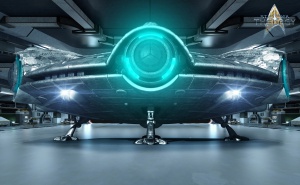
Technology
Asurian science drew heavily from the Sheromi. Everything from the basic laws of physics to FTL travel and advanced genetics came from the Sheromi.
The Sheromi were a highly advanced race that had time to develop cloaking mechanisms superior to anything the Romulans or Klingons were using at the time (though both Romulans and Klingons were rapidly catching up.) They also developed methods of propulsion that allowed their ships to move as if the laws of physics and aerodynamics didn’t exist.
Their saucers had the ability to stop suddenly, turn on a dime, and move straight up into the air, even in an atmosphere. The key to this lay in both the paneling used on the outside of the saucers and the engine on the inside. The paneling was made of an alloy similar to what was used on Federation ships, but covered with a specially formulated coating that reduced air resistance to zero.
The saucer engines were called RF resonant cavity thrusters, a kind of technology considered theoretical by the Federation. This enabled omnidirectional travel with no directional radiation. This same engine was present in all Sheromi motherships (‘Spheres’). Though the motherships weren't meant to land on and take off from a planet, its sphere shape allowed it to do so with minimal air resistance.
Sheromi hand weaponry relied on cold fusion instead of plasma. On low settings, a Sheromi hand phaser would deliver a shock of cold as well as a stun by using the plasma particle's effect on the nervous system. Asurian weaponry took the same principles used to make the Sheromi graviton beam technology, and made a rifle with a longer range and a smaller, more powerful shot. The Asurians also created a handheld canon that emitted a steady stream instead of just one shot.
The primary use of Saucers was observation and scientific testing, so weaponry was minimal. Most saucers relied on deflector beam arrays. Saucers were usually equipped with a powerful tractor beam. The usual image of a Saucer lifting humans up into the ship with a beam of light was only partially true: the tractor beam emitted no light of its own. Lights were installed for saucers observing humans because the Sheromi noticed that humans were drawn to mysterious lights far more than the usual pheromone-emitters the Sheromi had been using up until the nineteen-thirties.
Sheromi motherships used a geodesic fold array, which weaponized folds in space. They were very powerful and were to be used sparingly, according to Sheromi protocol, but the Asurians overlooked that rule when pirating. Motherships also kept a set of four Sheromi torpedo launchers. The torpedo explosion itself wasn't very large, but it left behind massive amounts of tetryon radiation meant to disable ships without breaching their hulls. All torpedoes were expended in the Three Wars. Because the Asurians did not know how to replace the torpedoes, they were left without such weaponry, which was the main reason why Asurians did not assault the new Sheromi at first.
Mythology
Asurian mythology was not very well developed. What the Asurians called their mythology was actually just their history as they understood it. Asurians were not a very religious group of people and their beliefs about what their place in the world was, where they went when they died, and what was truly right were severely fragmented. They had a hard time understanding other cultures’ mythology because they had no frame of reference with which to compare it to; telling an Asurian that the Chinese believed in dragon spirits would result in that Asurian believing literal dragons lived with the Chinese.
Special Notes
Asurians and Sheromi eventually found themselves in the middle of peace negotiations. The Sheromi sought peace, as was their nature, and the Asurians desperately needed resources and a new home. In order to solidify the peace agreement, Asurians agreed to send an unspecified number of spies to pose as Starfleet cadets, and eventually officers. The Sheromi had a distinct "grey-man" appearance and had no chance of passing as human, but the Asurians were human enough to pass with some modifications. The Asurians chose some of their best and brightest for the task.
The Sheromi and Asurians worked together to invent a number of procedures that would make the chosen Asurians look human, including tail removal, de-scaling, de-horning, and suppression of the Velsren sac with regular injections of hormone. Asurian blood could not be changed as the procedures to do so were irreversible and potentially dangerous. The Sheromi transplanted the Asurian spies across Earth and gave them five years’ worth of time to adjust to the new culture. They also forged paperwork and records that these spies were without family for some reason or another. Their saucer-type craft would deliver hormone injections to control their Velsren sac and any other materials they might need. On top of that, the spies were to report back their findings on Earth culture and the United Federation of Planets. This data would aid the Sheromi in their study of humans, and it would help the Asurians make a decision regarding whether or not to join the Federation. The spies were instructed to not reveal their true form under any circumstances.
In spite of this, the Asurian known as Sar-unga Neleo revealed her true form to the crew of the Theurgy recently. Very few could predict what happened next.
